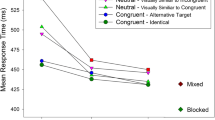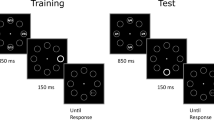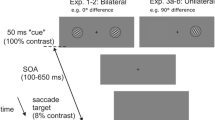Abstract
Inhibition of return (IOR) is characterized by a delay in responding to a target preceded by an irrelevant stimulus (cue) at the same location, or, in other words, by a response delay when the same location is stimulated twice. It is not clear, however, if the same phenomenon is present when there is a repetition of a simple nonspatial attribute of the stimulus. The present study examines the repetition of shape. Six experiments were conducted. In Experiments 1, 2, 3, and 6 the stimuli were geometrical shapes, whereas in Experiments 4 and 5 letters were used. In Experiment 1 all the stimuli were presented at fixation, whereas in Experiments 2 to 6 they were presented in the periphery. In Experiments 2 and 3, location and shape of the cue and the target were independently manipulated in order to test independently inhibitory effects (IOR?) attributable to location repetition and shape repetition. Results showed an inhibitory effect for location and a much smaller inhibitory effect for shape. The latter was restricted to the cued location. Experiments 4 and 5 tested the possibility that inhibition caused by shape repetition is due to repetition blindness. Experiment 6 contrasted the presence or absence of a central neutral attractor in the delay interval between presentation of the cue and the target. Taken together the results seem to favor IOR as the basis for the inhibition caused by shape repetition.



Similar content being viewed by others
Notes
Throughout the paper we will use the less committal terms "disadvantage" or "inhibition" when the nature of the phenomenon is uncertain, i.e., when the phenomenon might not be an instance of IOR.
We considered shape and location as two separable features of a figure. It is, however, uncertain if two figures with different shapes can occupy the same location because a small difference in shape produces a difference in location. IOR is thought to depend on the magnocellular system, which in turn depends substantially on input from the superior colliculus (Milner & Goodale, 1995). In effect there is much evidence (e.g., Posner et al., 1985; Rafal, Posner, Friedman, Inhoff, & Bernstein, 1988; Sapir, Soroker, Berger, & Henik, 1999; Simion, Valenza, Umiltà, & Dalla Barba, 1995) that the superior colliculus plays an important role in IOR. In the superficial layers of the superior colliculus in monkeys there are units that respond to two-dimensional shapes. The average receptive field of these neurons is 42°2 (Rizzolatti, Buchtel, Camarda, & Scandolara, 1980). Since we considered the distance between the outlines of the figures to be very small (less than .5°), it seems implausible that a discrimination in location between the two shapes might have occurred.
References
Bavelier, D., & Potter, M. C. (1992). Visual and phonological codes in repetition blindness. Journal of Experimental Psychology: Human Perception and Performance, 18, 134–147.
Berlucchi, G., Tassinari, G., Marzi, C. A., & Di Stefano, M. (1989). Spatial distribution of the inhibitory effect of peripheral non-informative cues on simple reaction time to non-fixed visual targets. Neuropsychologia, 27, 201–221.
Danzinger, S., & Kingstone, A. (1999). Unmasking the inhibition of return phenomenon. Perception & Psychophysics, 61, 1024–1037.
Duncan, J. (1984). Selective attention and the organization of visual information. Journal of Experimental Psychology: General, 113, 501–517.
Epstein, R., & Kanwisher, N. (1999). Repetition blindness for location: Evidence for automatic spatial coding in an RSVP task. Journal of Experimental Psychology: Human Perception and Performance, 25, 1855–1866.
Fox, E., & de Fockert, J. (2001). Inhibitory effects of repeating color and shape: Inhibition of return or repetition blindness? Journal of Experimental Psychology: Human Perception and Performance, 27, 798–812.
Fuentes, L. J., Vivas, A. B., & Humphreys, G. W. (1999). Inhibitory tagging of stimulus properties in inhibition of return: Effects on semantic priming and flanker interference. The Quarterly Journal of Experimental Psychology, 52A, 149–164.
Gawryszewski, L. G., Thomaz, T. G., Machado-Pinheiro, W., & Sant'Anna, A. N. (1994). Onset and offset of a visual cue have different effects on manual reaction time to a visual target. Brazilian Journal of Medical and Biological Research, 27, 67–73.
Georgeson, M. A., & Georgeson, J. M. (1987). Facilitation and masking of briefly presented gratings: Time-course and contrast dependence. Vision Research, 27, 369–379.
Humphreys, G. W., & Bruce, V. (1989). Visual Cognition. Hillsdale, NJ: Erlbaum.
Jordan, H., & Tipper, S. P. (1998). Object-based inhibition of return in static displays. Psychonomic Bulletin and Review, 5, 504–509.
Kanwisher, N. (1987). Repetition blindness: Type recognition without token individuation. Cognition, 27, 117–143.
Kanwisher, N. (1991). Repetition blindness and illusory conjunctions: Errors in binding visual types with visual tokens. Journal of Experimental Psychology: Human Perception and Performance, 17, 404–421.
Kanwisher, N., & Potter, M. C. (1990). Repetition blindness: Levels of processing. Journal of Experimental Psychology: Human Perception and Performance, 16, 30–47.
Kanwisher, N., Driver, J., & Machado, L. (1995). Spatial repetition blindness is modulated by selective attention to color and shape. Cognitive Psychology, 29, 303–337.
Klein, R. M. (1988). Inhibitory tagging system facilitates visual search. Nature, 334, 430–431.
Klein, R. M. (2000). Inhibition of return. Trends in Cognitive Sciences, 4, 138–147.
Klein, R. M., & Taylor, T. L. (1994). Categories of cognitive inhibition with reference to attention. In D. Dagenbach & T. H. Carr (Eds.), Inhibitory mechanisms in attention memory and language (pp. 113–150). San Diego: Academic Press.
Kwak, H., & Egeth, H. (1992). Consequences of allocating attention to locations and to other attributes. Perception & Psychophysics, 51, 455–464.
Lambert, A. J., & Hockey, G. R. J. (1991). Peripheral visual changes and spatial attention. Acta Psychologica, 76, 149–163.
Law, M. B., Pratt, J., & Abrams, R. A. (1995). Color-based inhibition of return. Perception & Psychophysics, 57, 402–408.
Maruff, P., Yucel, M., Dankert, J., Stuart, G., & Currie, J. (1999). Facilitation and inhibition arising from the exogenous orienting of covert attention depends on the temporal properties of spatial cues and targets. Neuropsychologia, 37, 731–744.
Maylor, E. A. (1985). Facilitatory and inhibitory components of orienting in visual space. In M. I. Posner & O. S. M. Marin (Eds.), Attention and Performance XI (pp. 189–204). Hillsdale, NJ: Erlbaum.
Maylor, E. A., & Hockey, G. R. J. (1985). Inhibitory component of externally controlled covert orienting in visual space. Journal of Experimental Psychology: Human Perception and Performance, 11, 777–787.
Maylor, E. A., & Hockey, G. R. J. (1987). Effects of repetition on the facilitatory and inhibitory components of orienting in visual space. Neuropsychologia, 25, 41–54.
Miller, J. (1988). Discrete and continuous models of human information processing: Theoretical distinctions and empirical results. Acta Psychologica, 67, 191–257.
Milner, A. D., & Goodale, M. A. (1995). The visual brain in action. Oxford: Oxford University Press.
Mondor, T. A., Breau, L. M., & Milliken, B. (1998). Inhibitory processes in auditory selective attention: Evidence of location-based and frequency-based inhibition of return. Perception & Psychophysics, 60, 296–302.
Oldfield, R. C. (1971). The assessment and analysis of handedness: The Edinburgh Inventory. Neuropsychologia, 9, 97–113.
Posner, M. I., & Cohen, Y. (1984). Components of visual orienting. In H. Bouma & D. Bouwhuis (Eds.), Attention and Performance X (pp. 531–556). Hillsdale, NJ: Erlbaum.
Posner, M. I., Rafal, R. D., Choate, S. L., & Vaughan, J. (1985). Inhibition of return: Neural basis and function. Cognitive Neuropsychology, 2, 211–228.
Possamaï, C. A. (1986). Relationship between inhibition and facilitation following a visual cue. Acta Psychologica, 61, 243–258.
Possamaï, C. A. (1991). A responding hand effect in a simple-RT precueing experiment: Evidence for a late locus of facilitation. Acta Psychologica, 77, 47–63.
Possamaï, C. A. (1992). The effect of non-informative cueing signal in a three-choice reaction-time task. Psychological Research, 54, 72–79.
Pratt, J., O'Donnell, C., & Morgan, A. (2000). The role of the fixation location in inhibition of return. Canadian Journal of Experimental Psychology, 54, 186–195.
Pratt, J., Hillis, J., & Gold, J. M. (2001). The effect of the physical characteristics of cues and targets on facilitation and inhibition. Psychonomic Bulletin & Review, 8, 489–495.
Rafal, R. D., Posner, M. I., Friedman, J. H., Inhoff, A. W., & Bernstein, E. (1988). Orienting of visual attention in progressive supranuclear palsy. Brain, 111, 267–280.
Rafal, R. D., Calabresi, P. A., Brennan, C. W., & Sciolto, T. K. (1989). Saccade preparation inhibits reorienting to recently attended locations. Journal of Experimental Psychology: Human Perception and Performance, 15, 673–685
Riggio, L., Bello, A., & Umiltà, C. (1998). Inhibitory and facilitatory effects of cue onset and offset. Psychological Research, 61, 107–118.
Riggio, L., Scaramuzza, E., & Umiltà, C. (2000). Modulation of inhibition of return by type and number of dynamic changes of the cue. Psychological Research, 64, 56–65.
Rizzolatti, G., Buchtel, H. A., Camarda, R., & Scandolara, C. (1980). Neurons with complex visual properties in the superior colliculus of macaque monkey. Experimental Brain Research, 38, 37–42.
Sanders, A. F. (1990). Issues and trends in the debate on discrete vs. continuous processing of information. Acta Psychologica, 74, 123–167.
Sapir, A., Soroker, N., Berger, A., & Henik, A. (1999). Inhibition of return in spatial attention: Direct evidence for collicular generation. Nature Neuroscience, 2, 1053–1054.
Schneider, W. (1988). Micro Experimental Laboratory: An integrated system for IBM PC compatibles. Behavior Research Methods, Instruments and Computers, 20, 206–217.
Simion, F., Valenza, E., Umiltà, C., & Dalla Barba, B. (1995). Inhibition of return in newborns is temporo-nasal asymmetrical. Infant Behavior and Development, 18, 189–194.
Sternberg, S. (1969). The discovery of processing stages: Extensions of Donder's method. Acta Psychologica, 30, 276–315.
Tassinari, G., & Berlucchi, G. (1993). Sensory and attentional components of slowing of manual reaction time to non-fixated visual targets by ipsilateral primes. Vision Research, 33, 1525–1534.
Tassinari, G., Aglioti, S., Chelazzi, L., Marzi, C. A., & Berlucchi, G. (1987). Distribution in the visual field of voluntarily allocated attention of the inhibitory aftereffects of covert orienting. Neuropsychologia, 25, 55–71.
Tassinari, G., Aglioti, S., Chelazzi, L., Peru, A., & Berlucchi, G. (1994). Do peripheral non-informative cues induce early facilitation of target detection? Vision Research, 34,179–189.
Taylor, T. L., & Klein, R. M. (1998). Inhibition of return to color: A replication and nonextension of Law, Pratt, and Abrams (1995). Perception & Psychophysics, 60, 1452–1456.
Tipper, S. P., Driver, J., & Weaver, B. (1991). Object-centered inhibition of return of visual attention. Quarterly Journal of Experimental Psychology, 43A, 289–298.
Tipper, S. P., Weaver, B., Jerreat, L. M., & Burak, A. L. (1994). Object-based and environment-based inhibition of return of visual attention. Journal of Experimental Psychology: Human Perception and Performance, 20, 478–499.
Tipper, S. P., Reuter-Lorenz, P. A., Rafal, R., Starrveldt, Y., Ro, T., Egly, R., Danzinger, S., & Weaver, B. (1997). Object-based facilitation and inhibition from visual orienting in the human split-brain. Journal of Experimental Psychology: Human Perception and Performance, 23, 1522–1532.
Tipper, S. P., Jordan, H., & Weaver, B. (1999). Scene-based and object-centered inhibition of return: Evidence for dual orienting mechanisms. Perception & Psychophysics, 61, 50–60.
Acknowledgements
This research was supported by grants from the CNR and MURST. We thank B. M. Sheliga and R. Tagliavini for their help during the study. We also thank L. F. Fuentes, H. Heuer, and an anonymous reviewer for very helpful comments on an earlier version of the paper.
Author information
Authors and Affiliations
Corresponding author
Rights and permissions
About this article
Cite this article
Riggio, L., Patteri, I. & Umiltà, C. Location and shape in inhibition of return. Psychological Research 68, 41–54 (2004). https://doi.org/10.1007/s00426-003-0136-7
Received:
Accepted:
Published:
Issue Date:
DOI: https://doi.org/10.1007/s00426-003-0136-7




